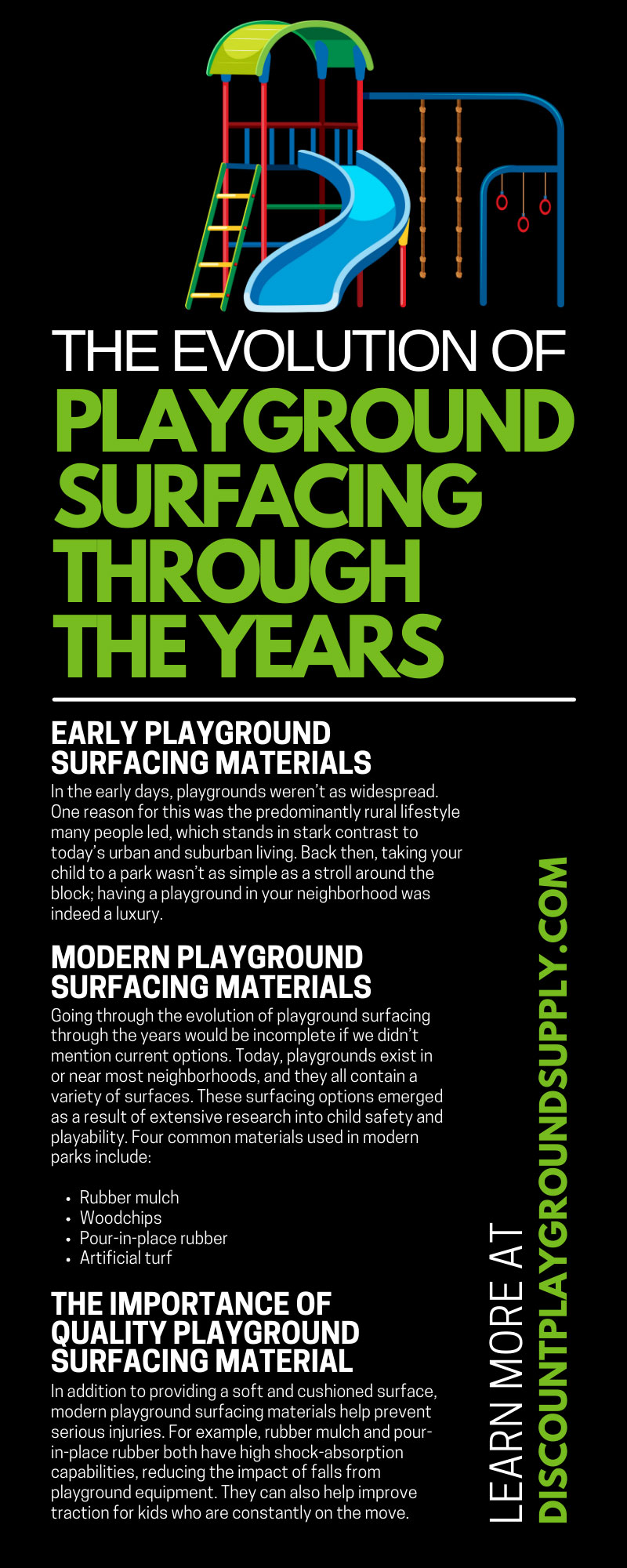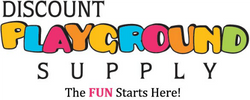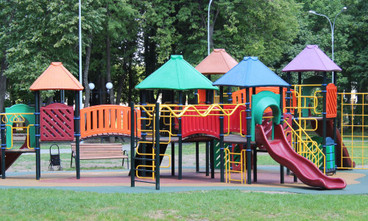Playgrounds are a quintessential part of childhood, offering kids a fun and engaging space to explore, socialize, and expend energy. However, like pretty much everything else, playgrounds have evolved significantly, particularly in regard to their surfacing. Explore the evolution of playground surfacing through the years and why these changes were necessary.
Early Playground Surfacing Materials
In the early days, playgrounds weren’t as widespread. One reason for this was the predominantly rural lifestyle many people led, which stands in stark contrast to today’s urban and suburban living. Back then, taking your child to a park wasn’t as simple as a stroll around the block; having a playground in your neighborhood was indeed a luxury.
During this era, sand was the go-to material for playground surfacing. It was readily available, highly affordable, and offered an ideal play surface for children.
The Issue With Sand
While sand was inexpensive and easy to source, it presented a significant problem: it became troublesome when wet. Natural weathering processes like rain and snow would transform the sand into a muddy, unplayable mess, ultimately highlighting the need for a change in playground surfacing.
Modern Playground Surfacing Materials
Going through the evolution of playground surfacing through the years would be incomplete if we didn’t mention current options. Today, playgrounds exist in or near most neighborhoods, and they all contain a variety of surfaces. These surfacing options emerged as a result of extensive research into child safety and playability. Four common materials used in modern parks include:
- Rubber mulch
- Woodchips
- Pour-in-place rubber
- Artificial turf
While many older playgrounds have woodchips covering the ground in certain areas, modern parks often have rubbery surfaces. These materials have unique benefits and drawbacks when it comes to cost, maintenance, safety, and accessibility.
Rubber Mulch
Often, manufacturers make rubber mulch with materials such as recycled, shredded tires. This option offers a soft and springy surface that absorbs impact well.
Pros and Cons of Rubber Mulch
If you’re considering using this material for your playground, keep in mind that rubber mulch isa soft and cushioned surface that can lessen the impact of falls. This material is also quite durable, so it’ll last through years of children playing on it.
While this material is a great option, there are two main cons of rubber mulch. The installation can be expensive, and it also requires regular maintenance, such as raking and filling in areas to keep the playground looking great.
Woodchips
Woodchips are a natural and affordable option for playground surfacing that used to be the go-to option at parks. They also provide a fairly soft and absorbent surface for falls.
Pros and Cons of Woodchips
Builders gravitate toward this material when constructing playgrounds because it is typically the least expensive modern option. Not to mention, engineered wood fiber has a natural look and feel.
However, engineered wood fiber has a few cons, such as the risk of splintering, which can cause children to get slivers. Woodchips are also problematic because they make the play area less accessible to those with mobility impairments.
Pour-in-Place Rubber
Often, pour-in-place rubber surfaces are ideal because they absorb the shock of falls and are highly durable. They also come in various thicknesses, meaning you can accommodate different playground equipment and potential fall heights.
Discount Playground Supply sells poured rubber playground flooring that’s latex-free, making it a safe option for everyone. With this product, you can repair your pour-in-place rubber surface and make patches as needed.
Pros and Cons of Pour-in-Place Rubber
One benefit of pour-in-place rubber is that there is a range of colors to choose from; you can also create fun and unique patterns with the pour. Additionally, pour-in-place rubber surfaces have a seamless look, enhancing the playground’s aesthetic.
Although, this surfacing option does have its drawbacks. It can be expensive to install depending on the playground size, and extremely cold temperatures can increase the risk of damage the surfacing may experience.
Artificial Turf
Artificial turf is not as common in playgrounds, but it offers a low-maintenance and durable option for surfacing that mimics the look of natural grass.
Pros and Cons of Artificial Turf
If you consider using artificial turf, remember that it is low-maintenance, long-lasting, and natural-looking.
As with every surface material, there are also some disadvantages to artificial turf. This includes a higher upfront cost compared to other surfacing options, and this material can become too hot to touch when it sits in direct sunlight. Additionally, it provides less cushioning for falls compared to other surfacing materials.
Weighing the pros and cons of each modern option can help you decide on the ideal surfacing material for your playground.
The Importance of Quality Playground Surfacing Material
No matter the material, it’s crucial to choose a high-quality playground surface for the safety and well-being of children. With proper installation and maintenance, these modern surfacing options provide a safe and inviting play area that can withstand the wear and tear of active kids.
Surface Materials Keep Playgrounds Safe
In addition to providing a soft and cushioned surface, modern playground surfacing materials help prevent serious injuries. For example, rubber mulch and pour-in-place rubber both have high shock-absorption capabilities, reducing the impact of falls from playground equipment. They can also help improve traction for kids who are constantly on the move.
Tips for Buying a Playground Surfacing Material
As you shop for the ideal playground surface material, keep the following tips in mind to ensure you make the best purchase:
- Consider the durability and maintenance needs of the material.
- Check for safety certifications and compliance with playground standards.
- Think about accessibility for children of all abilities.
- Factor in the budget for installation and maintenance costs.
By carefully evaluating these factors, you can decide on the best surface material for your playground. Some of these criteria may carry more weight than others depending on the location of the playground; for example, an elementary school will have different requirements than a community center.
Discount Playground Supply
As experts continue to improve playground surfacing, one thing remains constant—the importance of providing our children with safe and engaging outdoor play spaces. That’s why Discount Playground Supply is your go-to playground equipment and surface material supplier. Invest in quality products so all the kids in your community can play safely and happily for years to come.


